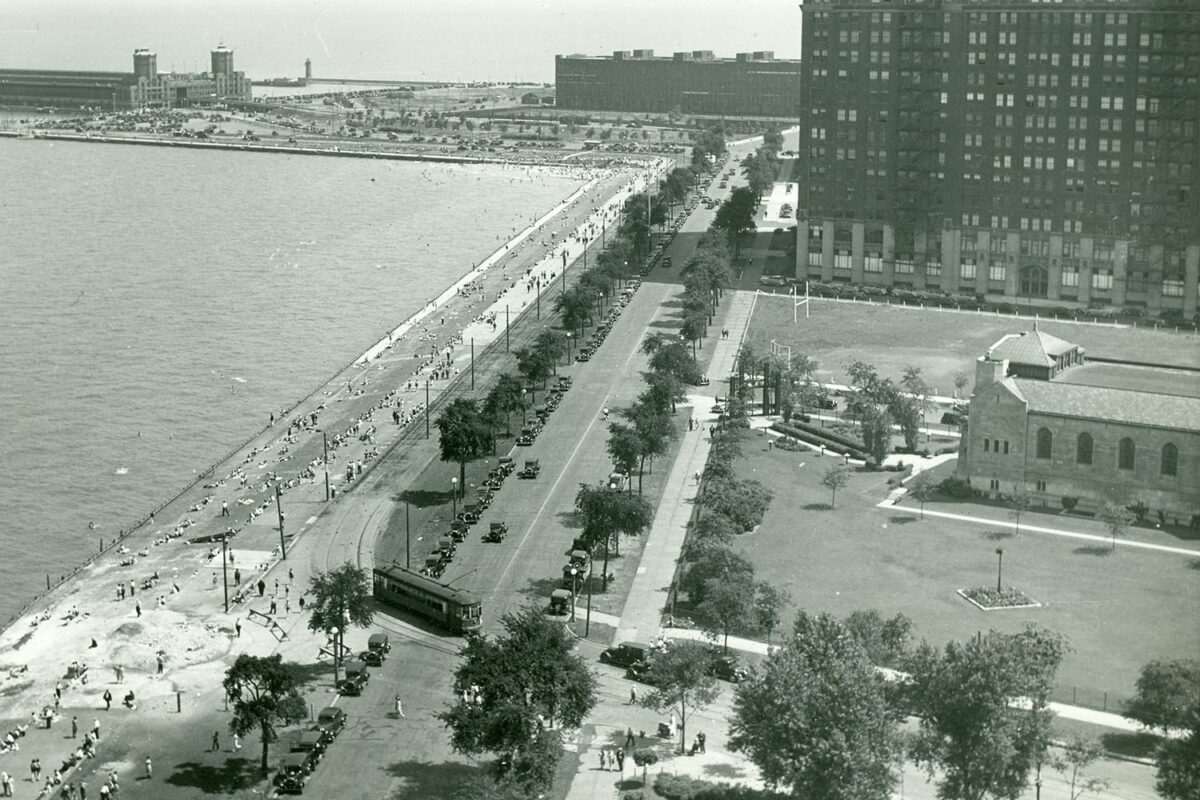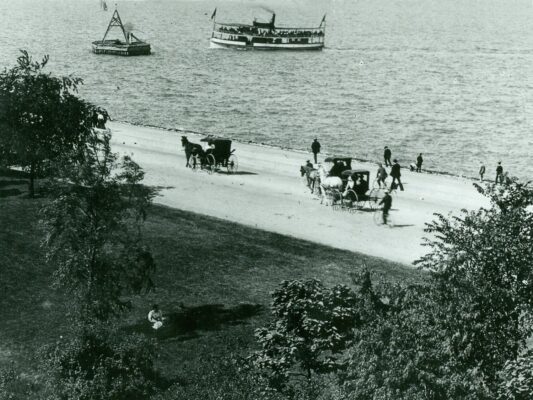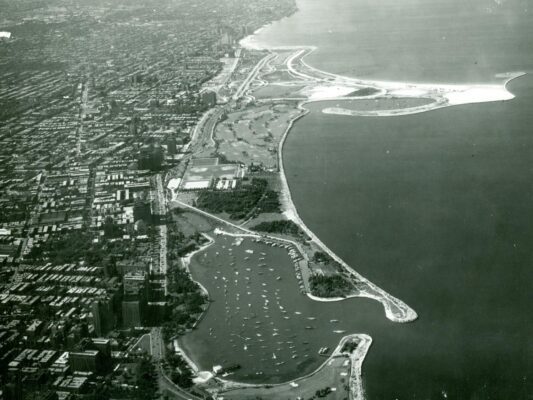
Civiltech’s newsletter, Between the Lines – Issue 57, featured an article on the approval of the Section 106 Historic Properties Identification (HPI) Report for the North DuSable Lake Shore Drive (NDLSD) Phase I Study. The article explained that the purpose of the Report is to document historic resources in a project’s Area of Potential Effects (APE) and is required when a federal agency is involved for a permit or funding. Since the NDLSD Study aims to use Federal-aid Highway Program funds, as administered by the Federal Highway Administration (FHWA), it is subject to compliance with Section 106.
A link to that article is available here.
A Deep Dive into Historic Research
In this article, we look at the research process used by the project team’s consulting historians, Julia Bachrach and Elizabeth Patterson. Both Julia and Elizabeth brought extensive knowledge and background to the project. Julia had previously authored the documents required to add Lincoln Park as a historic district on the National Register of Historic Places (NRHP) in 1994. Elizabeth, who had joined the NDLSD Phase I Study team early in the project, compiled a detailed history of NDLSD to provide context for the preliminary work of the Phase I team. Together, Julia and Elizabeth led a team of historians in conducting the extensive research to determine which of the hundreds of buildings adjacent to Lincoln Park may be eligible for listing on the NRHP.
Lincoln Park and its Adjacent Communities
To begin the research, the APE was divided into five Community Areas as determined by the City of Chicago— Near North, Lincoln Park, Lakeview, Uptown, and Edgewater. These are the five communities that are adjacent to Lincoln Park and NDLSD. The historians studied how the Park and the Drive affected the development and character of each community. Their work also included researching each community and the history of each of the neighborhoods within them. The team of historians determined how the neighborhoods developed; demographic changes over time; lifestyles and culture during different eras; significant buildings, architects, and architectural styles; the influential Chicagoans associated with specific buildings; and the unique Chicago culture born out of different communities. 
Researchers studied features and structures within the park that may have not qualified in the 1994 Lincoln Park NRHP nomination. With a 40-year cut-off date to retrospectively examine properties, no component of the Park added after World War II had been included in the 1994 NRHP designation. Park properties to be studied included a wide range of features such as structures (bridges, walls, etc.), land masses, buildings, gardens, statues and art, and recreational facilities.
Researching Individual Properties
The delineation of the APE was a complex task that considered any property impacted by the potential NDLSD project. Properties along the urban edge required additional determinants, including any property with views of the Park and the Drive. In instances in which shorter buildings stand along the urban edge, then taller buildings behind them also have views to the Park and Drive. Therefore, the APE at some locations needed to be several buildings deep, increasing the number of properties to be researched.
With over 300 individual properties included in the APE, the historians prepared a spreadsheet of every address and assigned specific buildings to different team members within the historian’s team. The team used National Park Service (NPS) guidelines and conducted research for each property within the APE that is currently 40 years old or older. Utilizing NRHP criteria, the analysis determined whether a property is historically significant due to American history, Chicago history, and/or neighborhood history; if a property was affiliated with a significant individual; and if a property was a noteworthy work by a significant architect or example of an architectural style.
Similar to the analyses of the communities, the historical significance of individual buildings often aligned with the history of NDLSD. Some buildings are significant in their own right, while others are significant due to their importance to the community and their relationship to NDLSD.
Tackling the Massive Research
To conduct this research, team members photographed every building in the APE. The historians then utilized many types of public records. Elizabeth stated that she likes to begin with fire insurance maps, which give an illustration of a city block with the outlines of buildings over time and create a snapshot of how the neighborhood developed. Also, she and Julia explained that historical newspapers, such as articles that are in the archives of the Chicago Tribune, can provide a trove of stories that supply pieces of the puzzle. The historians also looked at census records that give an indication of who lived in a specific property, their occupation, and whether they rented or owned, illustrating how occupancy changed over time. Original building permits helped the team identify developers, builders, architects, and in some cases, occupants.
The Final Report
The five-year project resulted in a final report and appendices which have been officially approved by the Illinois State Historic Preservation Office. The report includes a documented history of Lincoln Park, the development of the surrounding communities, and NDLSD itself. The complete report can be found on the NDLSD Phase I Study project website located here: https://northdusablelakeshoredrive.org/section_106_documents.html.
The final report identified 15 resources already listed in the NRHP, 10 resources previously determined as eligible for the NRHP and 150 resources recommended as eligible for the NRHP. The report also gives a comprehensive and thorough history of the interesting and noteworthy people, culture, and architecture of this renowned section of the City. 
An Exciting and Meaningful Project
Julia shared that this project was an opportunity of a lifetime for a historian, especially for she and Elizabeth, who have built their careers around Chicago’s rich and vibrant architectural and cultural histories. They explain that every building presents a research challenge, but always has a great story to tell. And, each piece of research is a clue leading to a new piece of the puzzle contributing to the magnificent story of North DuSable Lake Shore Drive, Lincoln Park, and their impact on the City of Chicago. Julia and Elizabeth also mentioned that the project was an especially rewarding because they so enjoy working together and also because they had other talented preservationists on the team including Jean Follett, Adam Rubin, and Christine Whims.
